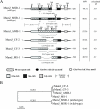The acidic repetitive domain of the Magnetospirillum gryphiswaldense MamJ protein displays hypervariability but is not required for magnetosome chain assembly
- PMID: 17601786
- PMCID: PMC1951895
- DOI: 10.1128/JB.00421-07
The acidic repetitive domain of the Magnetospirillum gryphiswaldense MamJ protein displays hypervariability but is not required for magnetosome chain assembly
Abstract
Magnetotactic bacteria navigate along the earth's magnetic field using chains of magnetosomes, which are intracellular organelles comprising membrane-enclosed magnetite crystals. The assembly of highly ordered magnetosome chains is under genetic control and involves several specific proteins. Based on genetic and cryo-electron tomography studies, a model was recently proposed in which the acidic MamJ magnetosome protein attaches magnetosome vesicles to the actin-like cytoskeletal filament formed by MamK, thereby preventing magnetosome chains from collapsing. However, the exact functions as well as the mode of interaction between MamK and MamJ are unknown. Here, we demonstrate that several functional MamJ variants from Magnetospirillum gryphiswaldense and other magnetotactic bacteria share an acidic and repetitive central domain, which displays an unusual intra- and interspecies sequence polymorphism, probably caused by homologous recombination between identical copies of Glu- and Pro-rich repeats. Surprisingly, mamJ mutant alleles in which the central domain was deleted retained their potential to restore chain formation in a DeltamamJ mutant, suggesting that the acidic domain is not essential for MamJ's function. Results of two-hybrid experiments indicate that MamJ physically interacts with MamK, and two distinct sequence regions within MamJ were shown to be involved in binding to MamK. Mutant variants of MamJ lacking either of the binding domains were unable to functionally complement the DeltamamJ mutant. In addition, two-hybrid experiments suggest both MamK-binding domains of MamJ confer oligomerization of MamJ. In summary, our data reveal domains required for the functions of the MamJ protein in chain assembly and maintenance and provide the first experimental indications for a direct interaction between MamJ and the cytoskeletal filament protein MamK.
Figures






Similar articles
-
Loss of the actin-like protein MamK has pleiotropic effects on magnetosome formation and chain assembly in Magnetospirillum gryphiswaldense.Mol Microbiol. 2010 Jul 1;77(1):208-24. doi: 10.1111/j.1365-2958.2010.07202.x. Epub 2010 May 12. Mol Microbiol. 2010. PMID: 20487281
-
Segregation of prokaryotic magnetosomes organelles is driven by treadmilling of a dynamic actin-like MamK filament.BMC Biol. 2016 Oct 12;14(1):88. doi: 10.1186/s12915-016-0290-1. BMC Biol. 2016. PMID: 27733152 Free PMC article.
-
The cation diffusion facilitator proteins MamB and MamM of Magnetospirillum gryphiswaldense have distinct and complex functions, and are involved in magnetite biomineralization and magnetosome membrane assembly.Mol Microbiol. 2011 Nov;82(4):818-35. doi: 10.1111/j.1365-2958.2011.07863.x. Epub 2011 Oct 18. Mol Microbiol. 2011. PMID: 22007638
-
Genetics and cell biology of magnetosome formation in magnetotactic bacteria.FEMS Microbiol Rev. 2008 Jul;32(4):654-72. doi: 10.1111/j.1574-6976.2008.00116.x. Epub 2008 Jun 2. FEMS Microbiol Rev. 2008. PMID: 18537832 Review.
-
Molecular analysis of a subcellular compartment: the magnetosome membrane in Magnetospirillum gryphiswaldense.Arch Microbiol. 2004 Jan;181(1):1-7. doi: 10.1007/s00203-003-0631-7. Epub 2003 Dec 11. Arch Microbiol. 2004. PMID: 14668979 Review.
Cited by
-
Magnetosome biogenesis in magnetotactic bacteria.Nat Rev Microbiol. 2016 Sep 13;14(10):621-37. doi: 10.1038/nrmicro.2016.99. Nat Rev Microbiol. 2016. PMID: 27620945 Review.
-
Frequent mutations within the genomic magnetosome island of Magnetospirillum gryphiswaldense are mediated by RecA.J Bacteriol. 2011 Oct;193(19):5328-34. doi: 10.1128/JB.05491-11. Epub 2011 Aug 5. J Bacteriol. 2011. PMID: 21821768 Free PMC article.
-
Engineering Magnetotactic Bacteria as Medical Microrobots.Adv Mater. 2025 Jul;37(27):e2416966. doi: 10.1002/adma.202416966. Epub 2025 Apr 17. Adv Mater. 2025. PMID: 40244080 Free PMC article. Review.
-
Screening for the interacting partners of the proteins MamK & MamJ by two-hybrid genomic DNA library of Magnetospirillum magneticum AMB-1.Curr Microbiol. 2012 Jun;64(6):515-23. doi: 10.1007/s00284-012-0099-2. Epub 2012 Mar 1. Curr Microbiol. 2012. PMID: 22382918
-
Silent gene clusters encode magnetic organelle biosynthesis in a non-magnetotactic phototrophic bacterium.ISME J. 2023 Mar;17(3):326-339. doi: 10.1038/s41396-022-01348-y. Epub 2022 Dec 14. ISME J. 2023. PMID: 36517527 Free PMC article.
References
-
- Ball, L. J., R. Kuhne, J. Schneider-Mergener, and H. Oschkinat. 2005. Recognition of proline-rich motifs by protein-protein-interaction domains. Angew. Chem. Int. Ed. 44:2852-2869. - PubMed
-
- Blakemore, R. P. 1975. Magnetotactic bacteria. Science 190:377-379. - PubMed
-
- Braun, V. 1995. Energy-coupled transport and signal-transduction through the Gram-negative outer-membrane via TonB-ExbB-ExbD-dependent receptor proteins. FEMS Microbiol. Rev. 16:295-307. - PubMed
-
- Dove, S. L., J. K. Joung, and A. Hochschild. 1997. Activation of prokaryotic transcription through arbitrary protein-protein contacts. Nature 386:627-630. - PubMed
Publication types
MeSH terms
Substances
LinkOut - more resources
Full Text Sources
Other Literature Sources
Molecular Biology Databases

